Attached files
| file | filename |
|---|---|
| 8-K - 8-K - ACI WORLDWIDE, INC. | d601664d8k.htm |
| EX-99.1 - EX-99.1 - ACI WORLDWIDE, INC. | d601664dex991.htm |
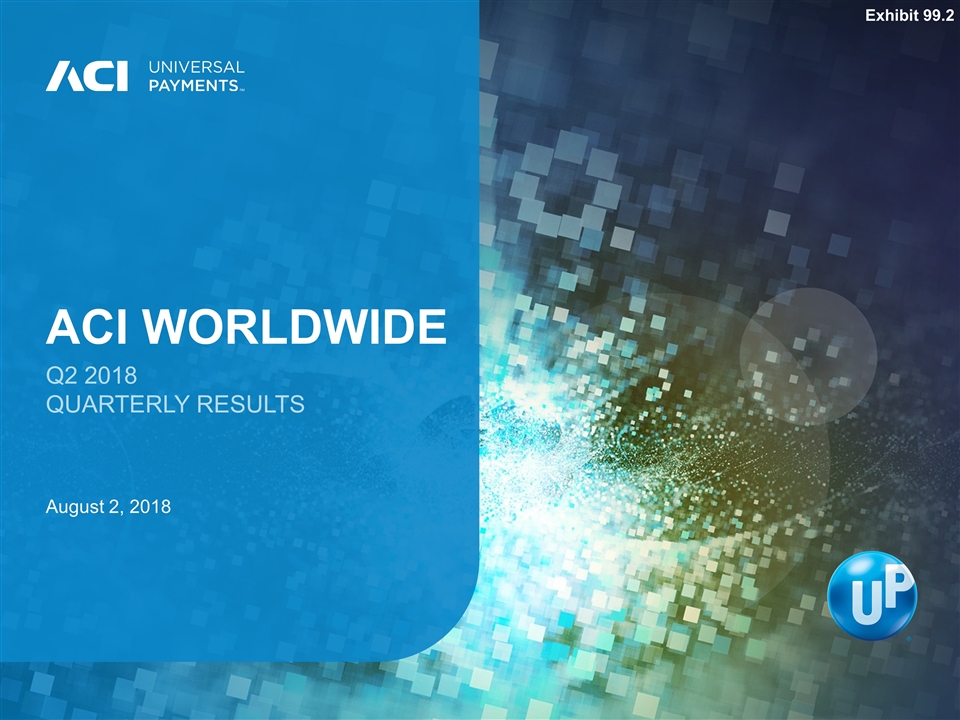
August 2, 2018 Q2 2018 Quarterly results ACI Worldwide Exhibit 99.2
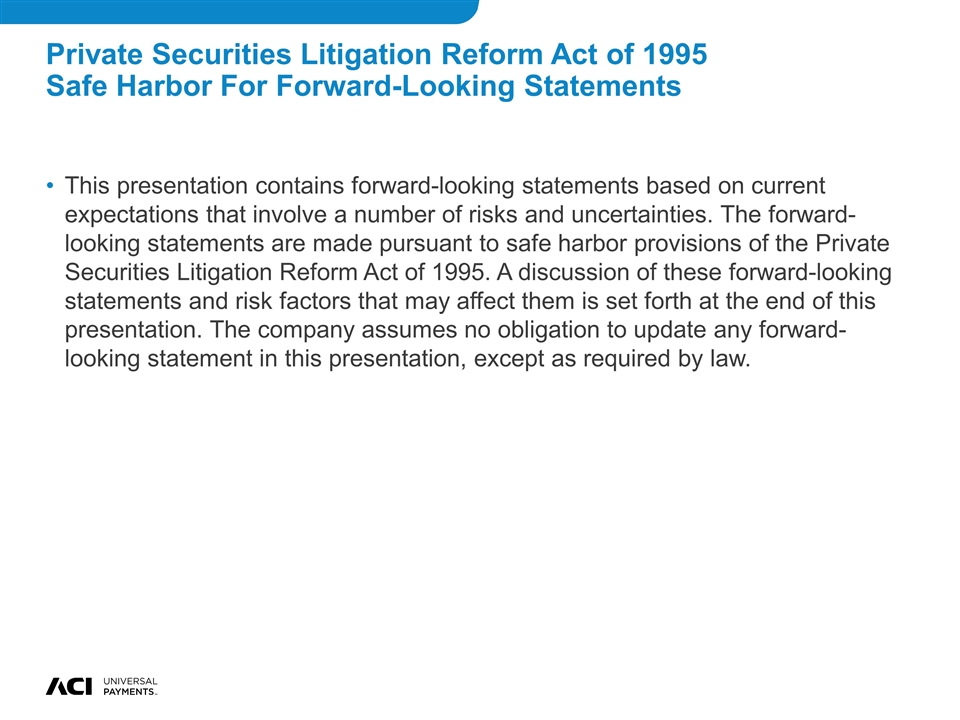
This presentation contains forward-looking statements based on current expectations that involve a number of risks and uncertainties. The forward-looking statements are made pursuant to safe harbor provisions of the Private Securities Litigation Reform Act of 1995. A discussion of these forward-looking statements and risk factors that may affect them is set forth at the end of this presentation. The company assumes no obligation to update any forward-looking statement in this presentation, except as required by law. Private Securities Litigation Reform Act of 1995 Safe Harbor For Forward-Looking Statements
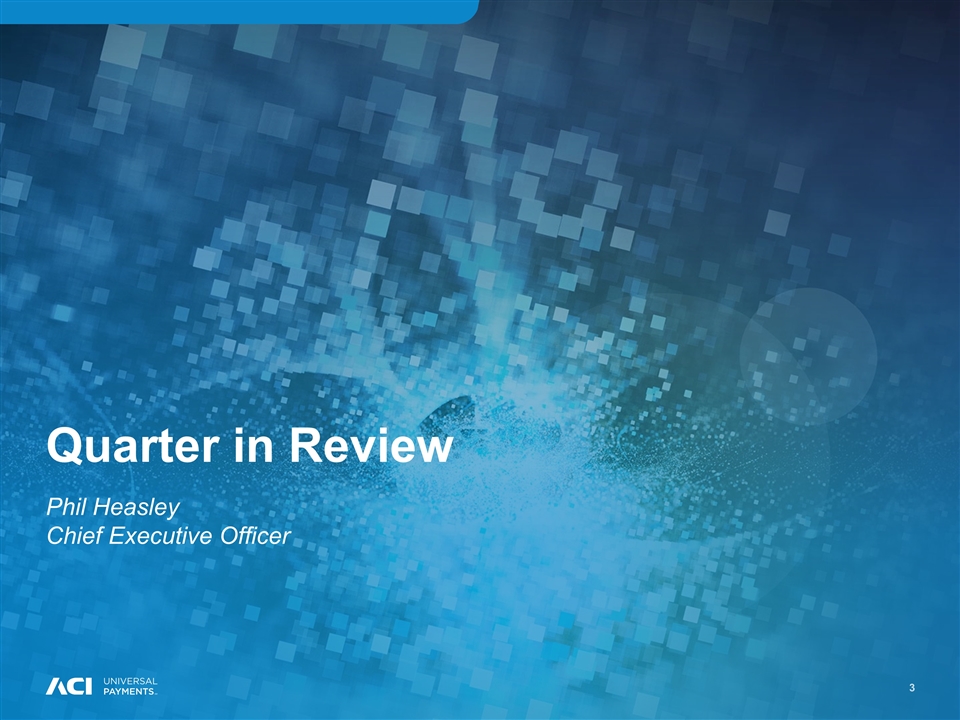
Phil Heasley Chief Executive Officer Quarter in Review
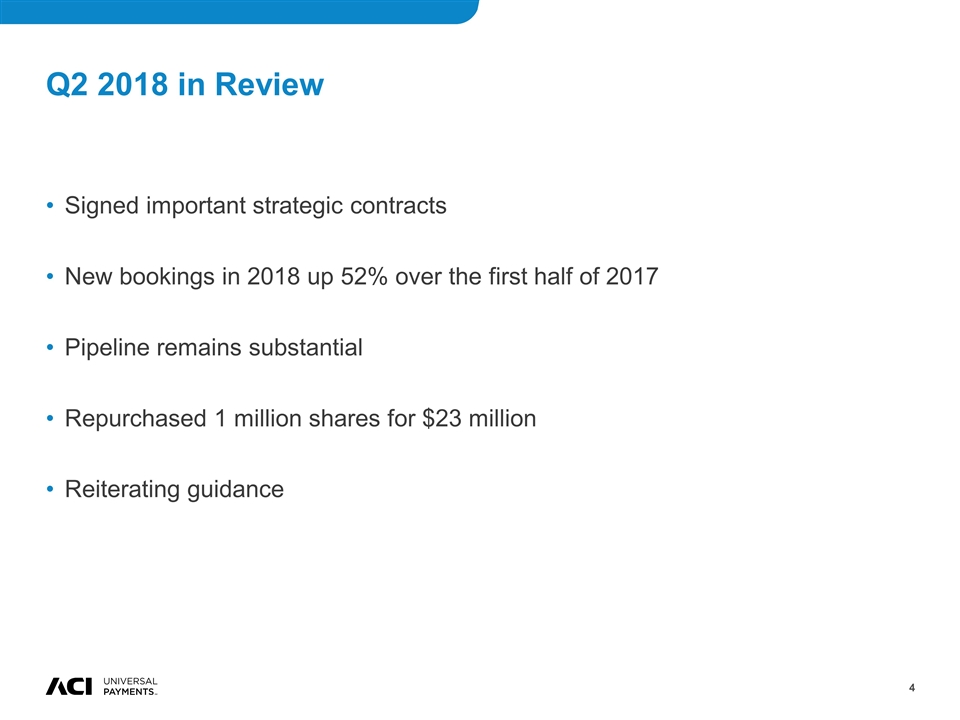
Signed important strategic contracts New bookings in 2018 up 52% over the first half of 2017 Pipeline remains substantial Repurchased 1 million shares for $23 million Reiterating guidance Q2 2018 in Review
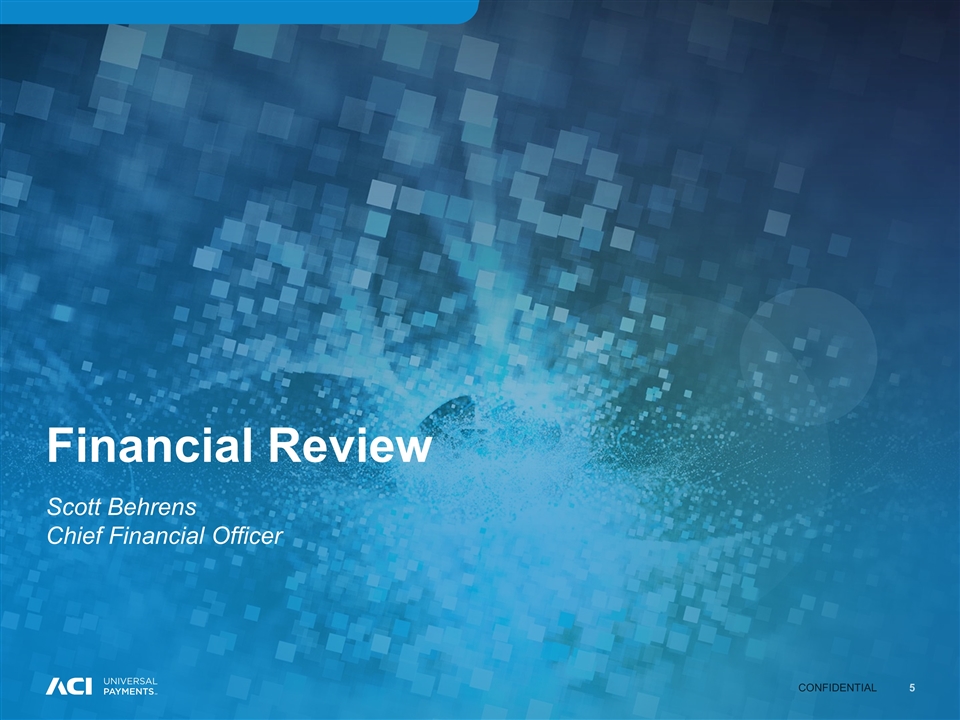
Confidential Scott Behrens Chief Financial Officer Financial Review
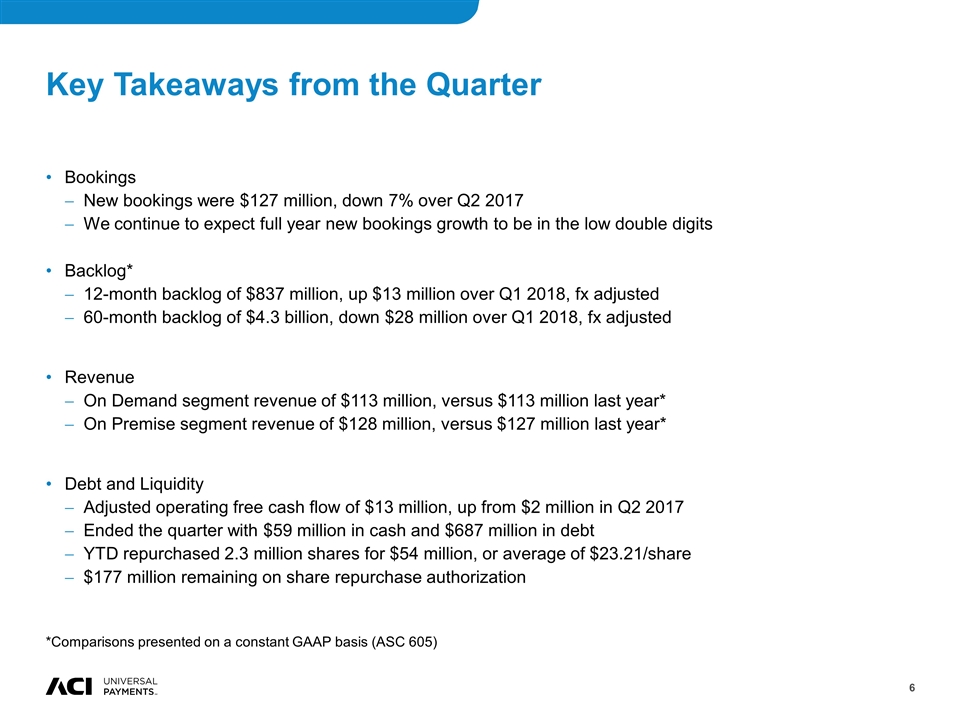
*Comparisons presented on a constant GAAP basis (ASC 605) Bookings New bookings were $127 million, down 7% over Q2 2017 We continue to expect full year new bookings growth to be in the low double digits Backlog* 12-month backlog of $837 million, up $13 million over Q1 2018, fx adjusted 60-month backlog of $4.3 billion, down $28 million over Q1 2018, fx adjusted Revenue On Demand segment revenue of $113 million, versus $113 million last year* On Premise segment revenue of $128 million, versus $127 million last year* Debt and Liquidity Adjusted operating free cash flow of $13 million, up from $2 million in Q2 2017 Ended the quarter with $59 million in cash and $687 million in debt YTD repurchased 2.3 million shares for $54 million, or average of $23.21/share $177 million remaining on share repurchase authorization Key Takeaways from the Quarter
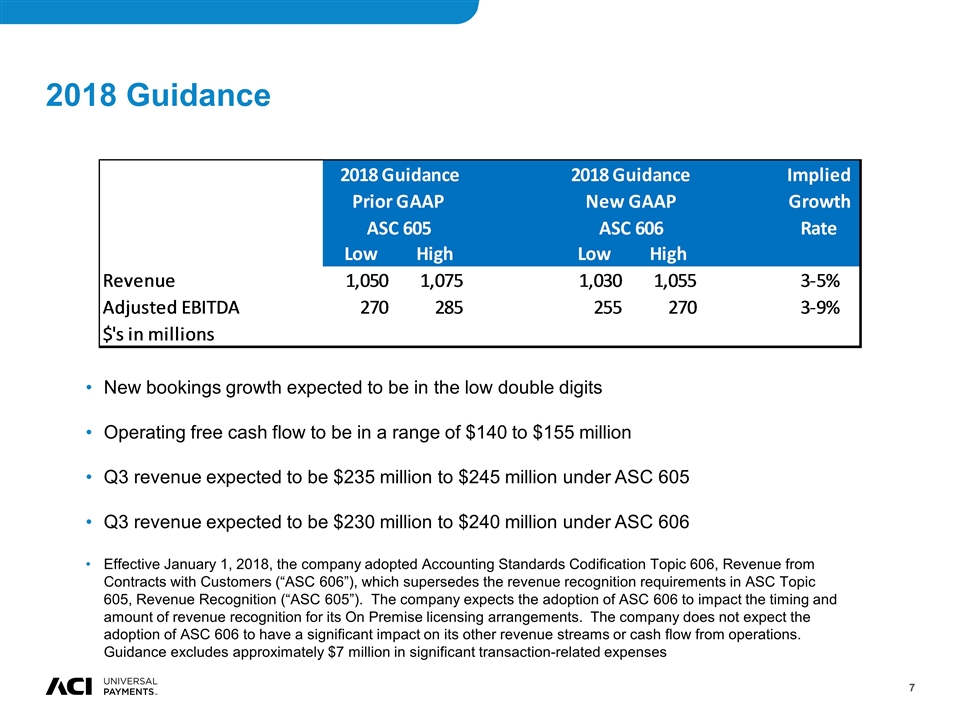
2018 Guidance New bookings growth expected to be in the low double digits Operating free cash flow to be in a range of $140 to $155 million Q3 revenue expected to be $235 million to $245 million under ASC 605 Q3 revenue expected to be $230 million to $240 million under ASC 606 Effective January 1, 2018, the company adopted Accounting Standards Codification Topic 606, Revenue from Contracts with Customers (“ASC 606”), which supersedes the revenue recognition requirements in ASC Topic 605, Revenue Recognition (“ASC 605”). The company expects the adoption of ASC 606 to impact the timing and amount of revenue recognition for its On Premise licensing arrangements. The company does not expect the adoption of ASC 606 to have a significant impact on its other revenue streams or cash flow from operations. Guidance excludes approximately $7 million in significant transaction-related expenses

Appendix
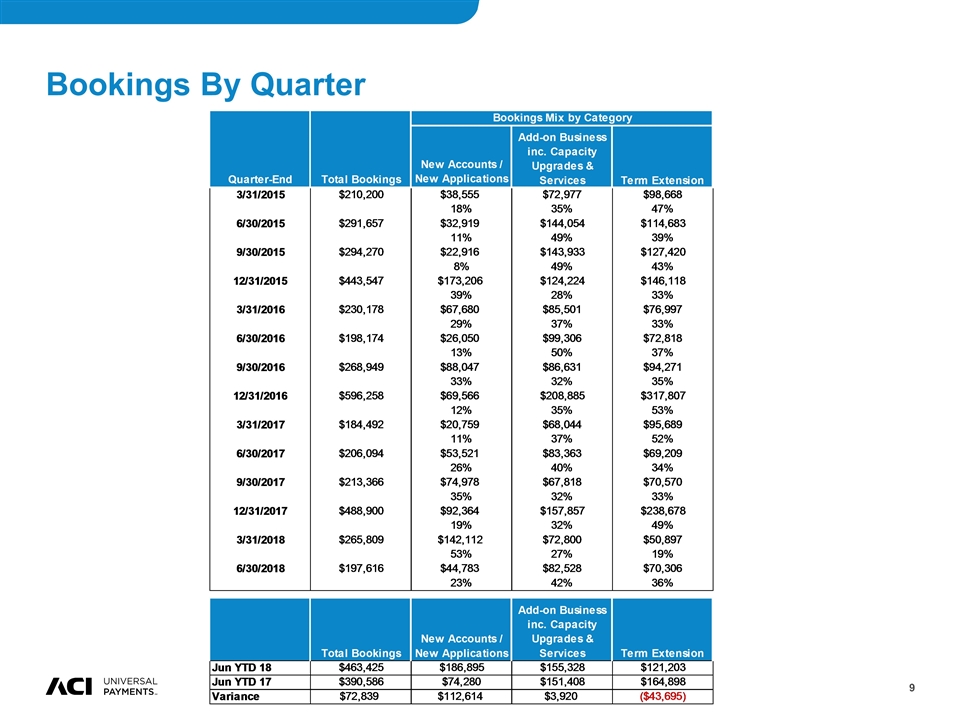
Bookings By Quarter
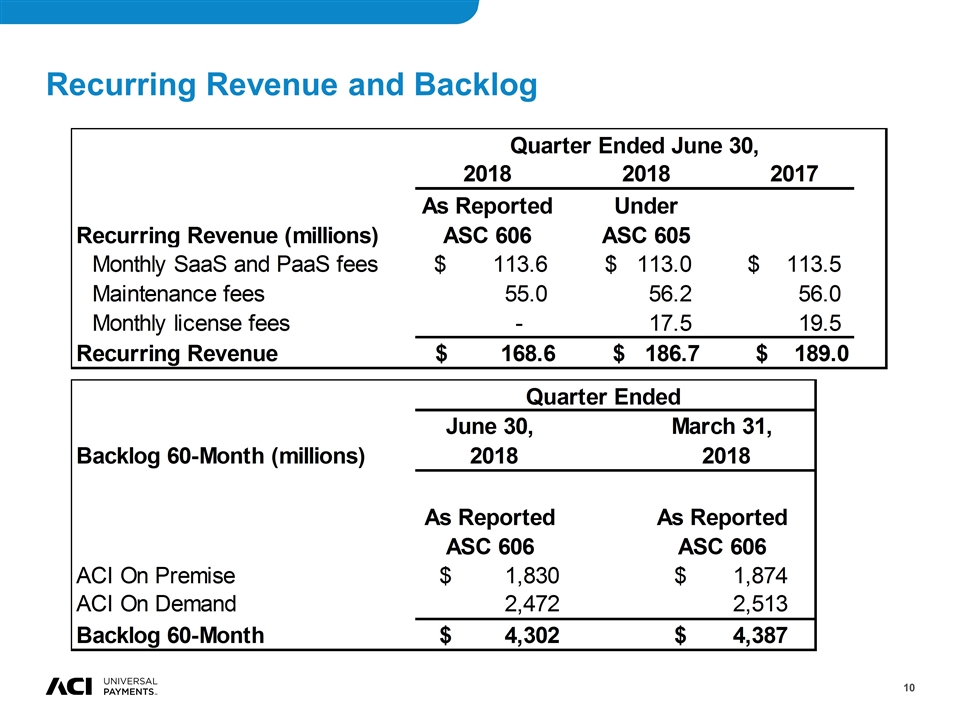
Recurring Revenue and Backlog
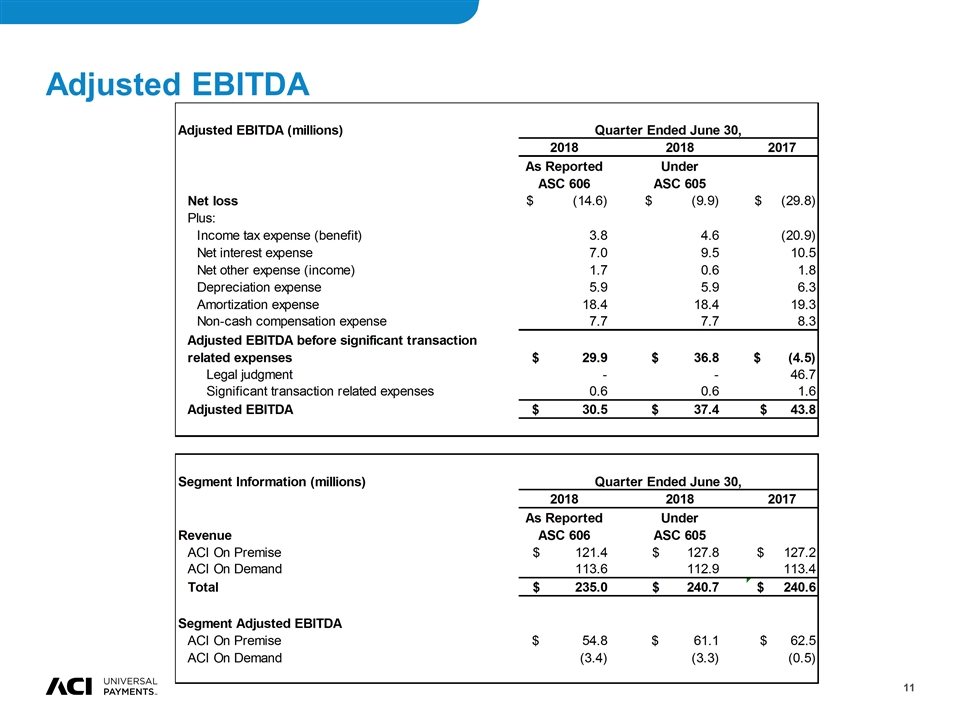
Adjusted EBITDA
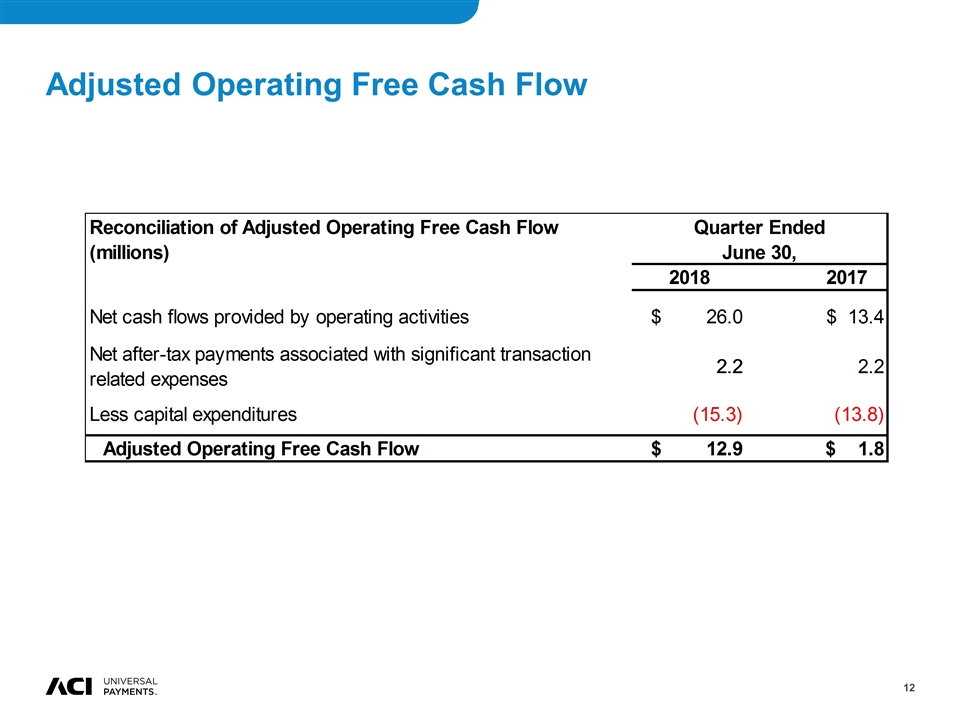
Adjusted Operating Free Cash Flow
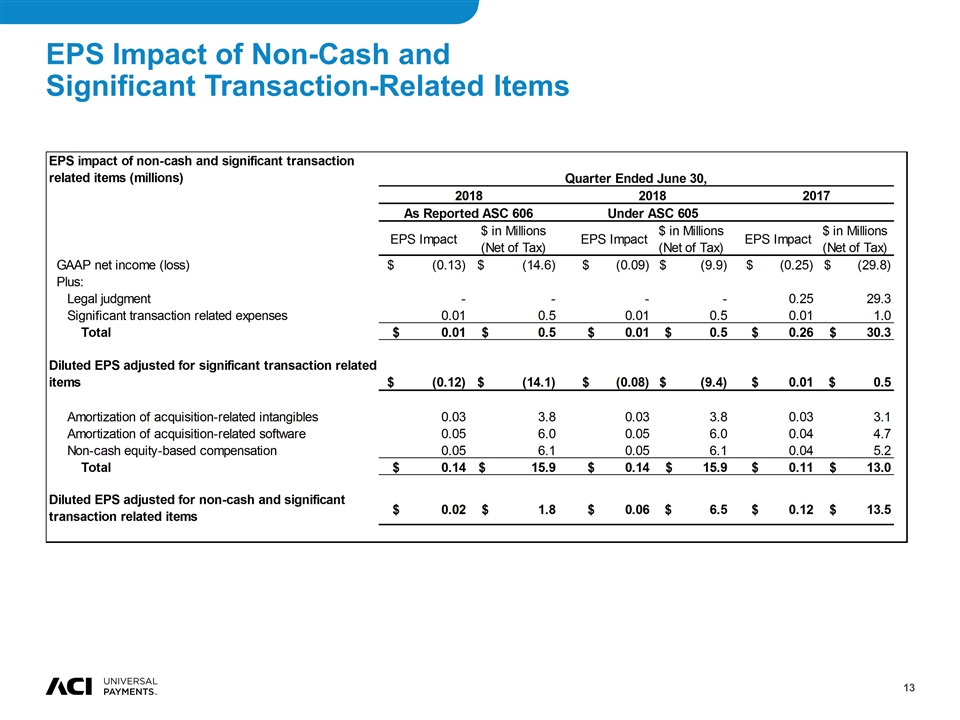
EPS Impact of Non-Cash and Significant Transaction-Related Items

Contract Duration Represents dollar average remaining contract life (in years) for term license software contracts Excludes perpetual contracts (primarily heritage S1 licensed software contracts) Excludes On Demand contracts as both cash and revenue are ratable over the contract term
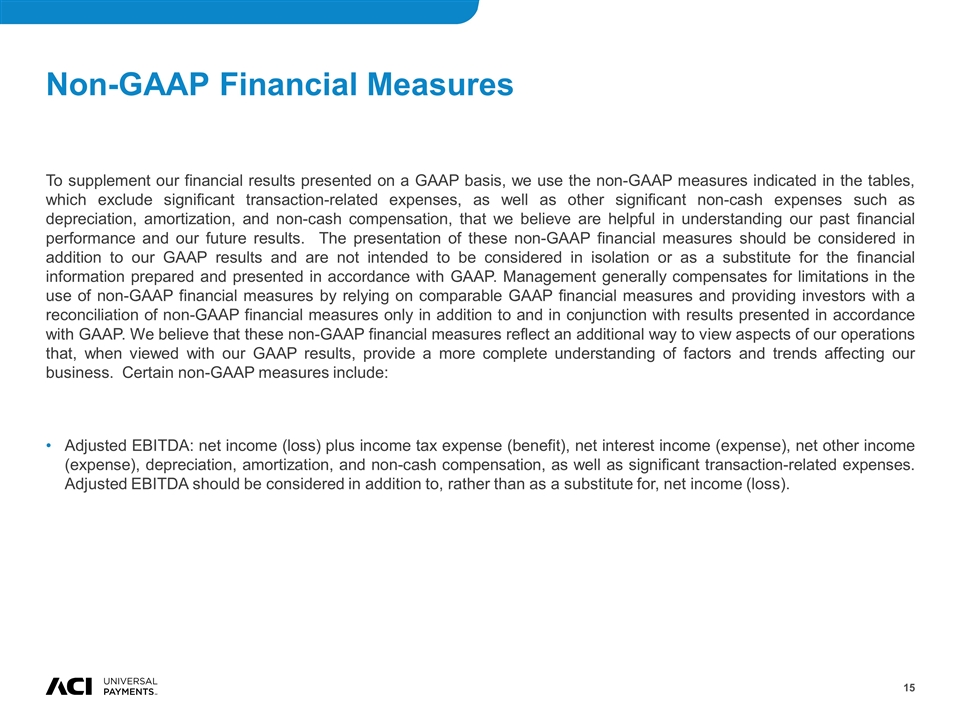
To supplement our financial results presented on a GAAP basis, we use the non-GAAP measures indicated in the tables, which exclude significant transaction-related expenses, as well as other significant non-cash expenses such as depreciation, amortization, and non-cash compensation, that we believe are helpful in understanding our past financial performance and our future results. The presentation of these non-GAAP financial measures should be considered in addition to our GAAP results and are not intended to be considered in isolation or as a substitute for the financial information prepared and presented in accordance with GAAP. Management generally compensates for limitations in the use of non-GAAP financial measures by relying on comparable GAAP financial measures and providing investors with a reconciliation of non-GAAP financial measures only in addition to and in conjunction with results presented in accordance with GAAP. We believe that these non-GAAP financial measures reflect an additional way to view aspects of our operations that, when viewed with our GAAP results, provide a more complete understanding of factors and trends affecting our business. Certain non-GAAP measures include: Adjusted EBITDA: net income (loss) plus income tax expense (benefit), net interest income (expense), net other income (expense), depreciation, amortization, and non-cash compensation, as well as significant transaction-related expenses. Adjusted EBITDA should be considered in addition to, rather than as a substitute for, net income (loss). Non-GAAP Financial Measures
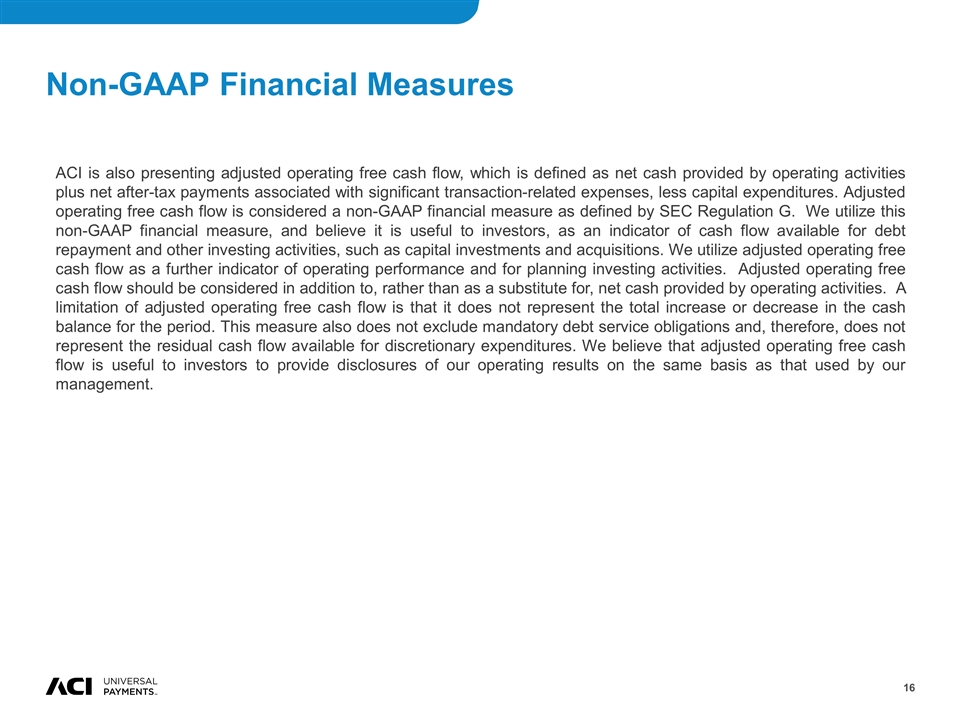
Non-GAAP Financial Measures ACI is also presenting adjusted operating free cash flow, which is defined as net cash provided by operating activities plus net after-tax payments associated with significant transaction-related expenses, less capital expenditures. Adjusted operating free cash flow is considered a non-GAAP financial measure as defined by SEC Regulation G. We utilize this non-GAAP financial measure, and believe it is useful to investors, as an indicator of cash flow available for debt repayment and other investing activities, such as capital investments and acquisitions. We utilize adjusted operating free cash flow as a further indicator of operating performance and for planning investing activities. Adjusted operating free cash flow should be considered in addition to, rather than as a substitute for, net cash provided by operating activities. A limitation of adjusted operating free cash flow is that it does not represent the total increase or decrease in the cash balance for the period. This measure also does not exclude mandatory debt service obligations and, therefore, does not represent the residual cash flow available for discretionary expenditures. We believe that adjusted operating free cash flow is useful to investors to provide disclosures of our operating results on the same basis as that used by our management.
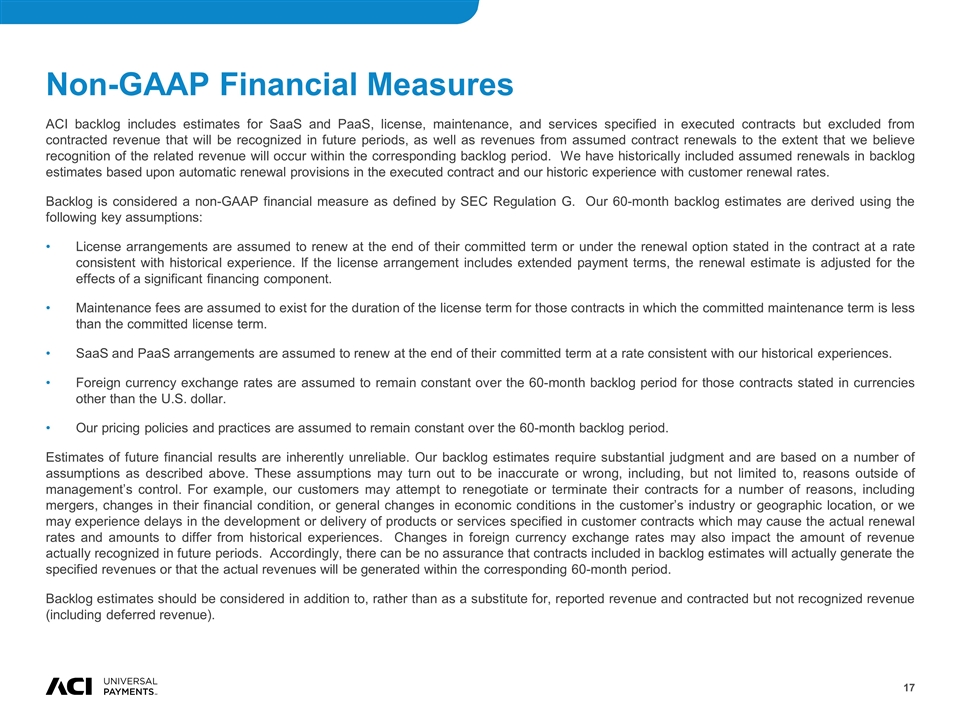
ACI backlog includes estimates for SaaS and PaaS, license, maintenance, and services specified in executed contracts but excluded from contracted revenue that will be recognized in future periods, as well as revenues from assumed contract renewals to the extent that we believe recognition of the related revenue will occur within the corresponding backlog period. We have historically included assumed renewals in backlog estimates based upon automatic renewal provisions in the executed contract and our historic experience with customer renewal rates. Backlog is considered a non-GAAP financial measure as defined by SEC Regulation G. Our 60-month backlog estimates are derived using the following key assumptions: License arrangements are assumed to renew at the end of their committed term or under the renewal option stated in the contract at a rate consistent with historical experience. If the license arrangement includes extended payment terms, the renewal estimate is adjusted for the effects of a significant financing component. Maintenance fees are assumed to exist for the duration of the license term for those contracts in which the committed maintenance term is less than the committed license term. SaaS and PaaS arrangements are assumed to renew at the end of their committed term at a rate consistent with our historical experiences. Foreign currency exchange rates are assumed to remain constant over the 60-month backlog period for those contracts stated in currencies other than the U.S. dollar. Our pricing policies and practices are assumed to remain constant over the 60-month backlog period. Estimates of future financial results are inherently unreliable. Our backlog estimates require substantial judgment and are based on a number of assumptions as described above. These assumptions may turn out to be inaccurate or wrong, including, but not limited to, reasons outside of management’s control. For example, our customers may attempt to renegotiate or terminate their contracts for a number of reasons, including mergers, changes in their financial condition, or general changes in economic conditions in the customer’s industry or geographic location, or we may experience delays in the development or delivery of products or services specified in customer contracts which may cause the actual renewal rates and amounts to differ from historical experiences. Changes in foreign currency exchange rates may also impact the amount of revenue actually recognized in future periods. Accordingly, there can be no assurance that contracts included in backlog estimates will actually generate the specified revenues or that the actual revenues will be generated within the corresponding 60-month period. Backlog estimates should be considered in addition to, rather than as a substitute for, reported revenue and contracted but not recognized revenue (including deferred revenue). Non-GAAP Financial Measures
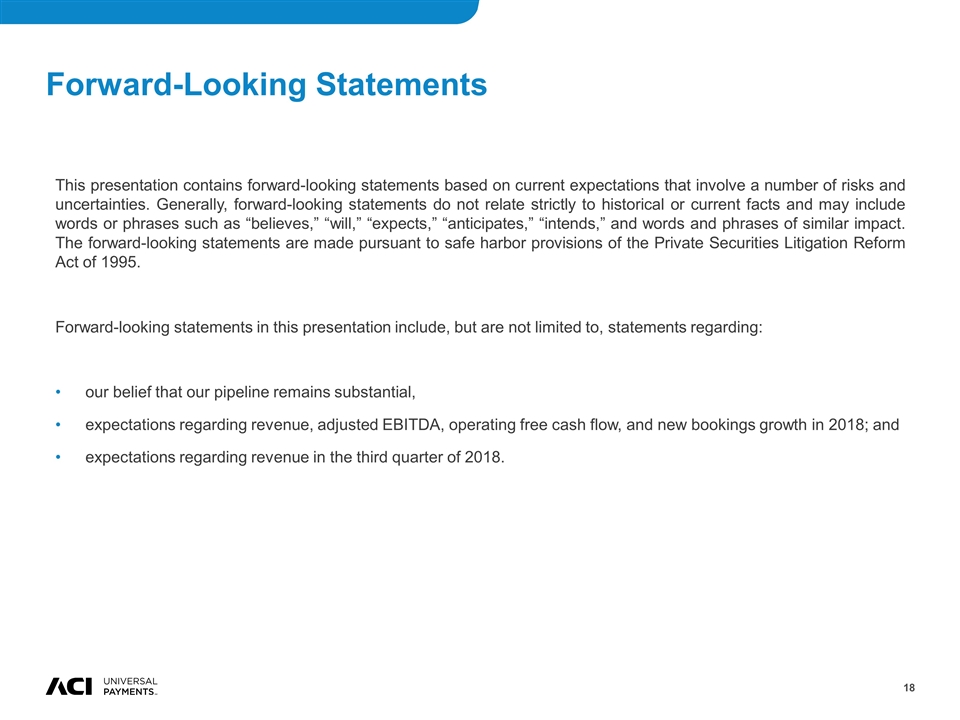
This presentation contains forward-looking statements based on current expectations that involve a number of risks and uncertainties. Generally, forward-looking statements do not relate strictly to historical or current facts and may include words or phrases such as “believes,” “will,” “expects,” “anticipates,” “intends,” and words and phrases of similar impact. The forward-looking statements are made pursuant to safe harbor provisions of the Private Securities Litigation Reform Act of 1995. Forward-looking statements in this presentation include, but are not limited to, statements regarding: our belief that our pipeline remains substantial, expectations regarding revenue, adjusted EBITDA, operating free cash flow, and new bookings growth in 2018; and expectations regarding revenue in the third quarter of 2018. Forward-Looking Statements
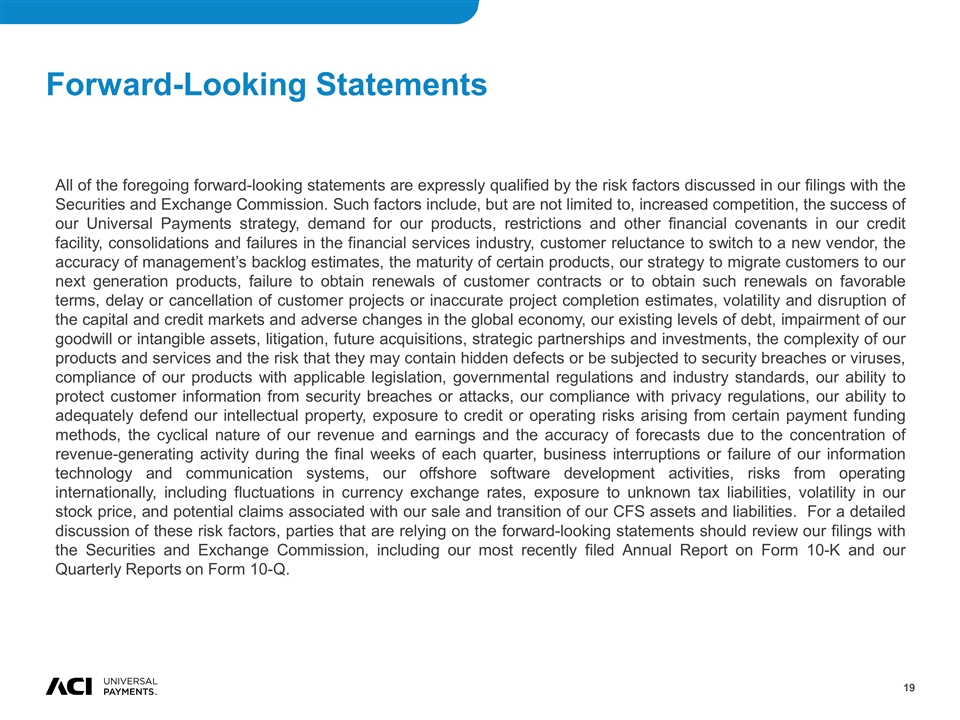
All of the foregoing forward-looking statements are expressly qualified by the risk factors discussed in our filings with the Securities and Exchange Commission. Such factors include, but are not limited to, increased competition, the success of our Universal Payments strategy, demand for our products, restrictions and other financial covenants in our credit facility, consolidations and failures in the financial services industry, customer reluctance to switch to a new vendor, the accuracy of management’s backlog estimates, the maturity of certain products, our strategy to migrate customers to our next generation products, failure to obtain renewals of customer contracts or to obtain such renewals on favorable terms, delay or cancellation of customer projects or inaccurate project completion estimates, volatility and disruption of the capital and credit markets and adverse changes in the global economy, our existing levels of debt, impairment of our goodwill or intangible assets, litigation, future acquisitions, strategic partnerships and investments, the complexity of our products and services and the risk that they may contain hidden defects or be subjected to security breaches or viruses, compliance of our products with applicable legislation, governmental regulations and industry standards, our ability to protect customer information from security breaches or attacks, our compliance with privacy regulations, our ability to adequately defend our intellectual property, exposure to credit or operating risks arising from certain payment funding methods, the cyclical nature of our revenue and earnings and the accuracy of forecasts due to the concentration of revenue-generating activity during the final weeks of each quarter, business interruptions or failure of our information technology and communication systems, our offshore software development activities, risks from operating internationally, including fluctuations in currency exchange rates, exposure to unknown tax liabilities, volatility in our stock price, and potential claims associated with our sale and transition of our CFS assets and liabilities. For a detailed discussion of these risk factors, parties that are relying on the forward-looking statements should review our filings with the Securities and Exchange Commission, including our most recently filed Annual Report on Form 10-K and our Quarterly Reports on Form 10-Q. Forward-Looking Statements
